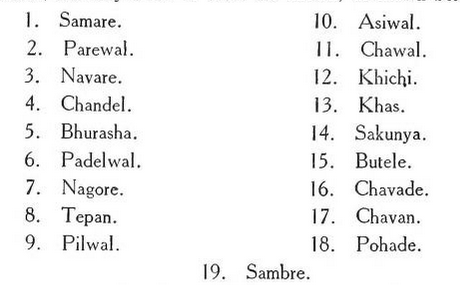Khatik: Deccan
Contents |
Khatik
This article is an extract from THE CASTES AND TRIBES OF H. E. H. THE NIZAM'S DOMINIONS BY SYED SIRAJ UL HASSAN Of Merton College, Oxford, Trinity College, Dublin, and Middle Temple, London. One of the Judges of H. E. H. the Nizam's High Court of Judicature : Lately Director of Public Instruction. BOMBAY THE TlMES PRESS 1920 Indpaedia is an archive. It neither agrees nor disagrees |
Khatik, Sultankar, Alitkar — the tanner caste, supposed to have come from Nagar in Marwar more than t\^o hundred years ago. According to the traditions current among the people, they are des- cended from Dharmaraja, the eldest of the Pandav brothers. The members of the caste are tall, strong, with an alert expression, and speak Hindustani with a mixture of Marwari. They have no endo- gamous divisions. They say they have got eighty-four exogamous sections, but only a few of these are known, as shown below —
A man is forbidden to marry a woman belonging to his own section. No other section is a bar to marriage, provided that he does not marry any of his first cousins. This rule of exogamy is further supplemented by prohibited degrees, calculated to three generations in the descending line.
Marriage
Both adult and infant marriage are recognised by the caste, but the latter is deemed the more respectable. The marriage ceremony is of the orthodox type. On the wedding day, the bridegroom goes to the bride's house where, on arrival, he is con- ducted to a seat under a wedding canopy or mandap. There the bride joins him and is seated on his left hand. A sacred fire is kindled before them by the priest and the bride's maternal uncle puts her left hand into the bridegroom's right hand. After the clothes of the bridal pair have been knotted together by the officiating Brahman, they walk seven times round the milk post (mani khamh). This is followed by Kanyadan, or the giving away of the bride by her parents and the bridegroom's acceptance of her. The seven circuits, taken by the bridal pair round the milk post and the sacred fire, are deemed to be the binding portion of the ceremony. Poly- gamy is permitted and there is no positive rule fixing any limit to the number of wives a man may have. Most Khatiks, however, are too poor to keep more than one wife, and a man only takes a second wife when the first is barren. A widow may marry again, but she is not required to marry her late husband's younger brother. Divorce is permitted with the sanction of the Pancha\)at and divorced wives may marry again by the form in use at the remaniage of widows.
Religion
By religion, the Khatiks are orthodox Hindus and employ Maratha Brahmans for religious and ceremonial purposes. Their chief deities are Bhairoba of Nagar, in Marwar, and Amba Bhavani of Tuljapur, who are worshipped at their weddings. A goat is sacrificed in the name of Bhavani on the Dassera, or the tenth of the light half of Aswin (September). If smallpox breaks out in the family, they appease the goddess Sitala with offerings of goats and fowls. The dead are usually burnt, but recourse is had to burial if the deceased is an unmarried person. When the body is burned, the ashes are collected on the third day after death and thrown into a river. Smdha is performed on the tenth day when pmdas, or balls of rice, are offered for the benefit of the soul of the deceased. On the eleventh day, the chief mourner shaves and becomes purified. The funeral ceremony is closed by a feast to the members of the caste.
Occupation
The characteristic occupation of the caste is the tanning of leather. They buy hides from the neighbouring villages and sell them, after dressing, to Chammars and Bohoras. In tan- ning, they use the red lac dye, math (a kind of bean), salt, and the bark of the taroar {Cassia amiculata). Socially, the Khatiks rank very low. They will eat fish and fowl and the flesh of hare, deer and goat, but abstain from beef and pork. They indulge freely m spirituous and fermented liquors.
